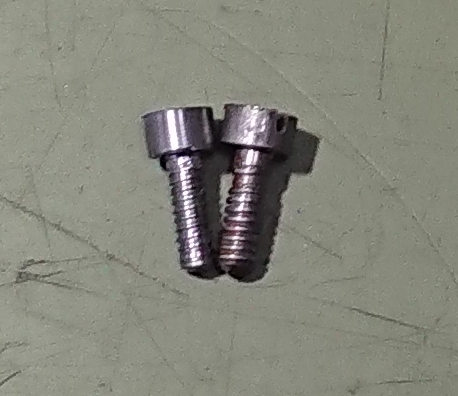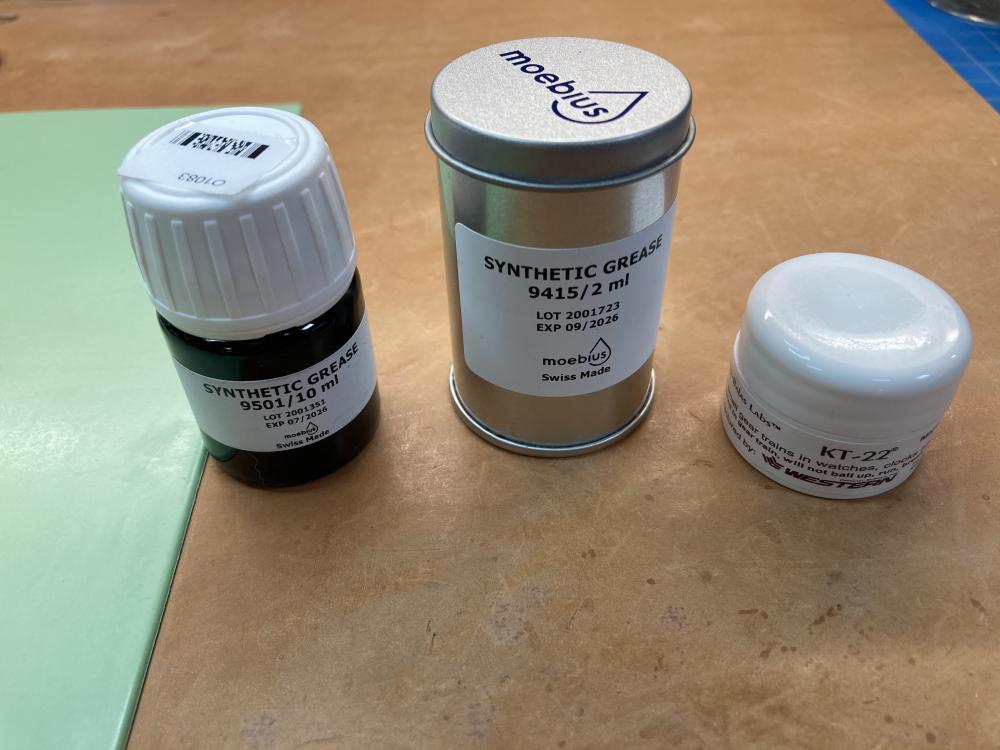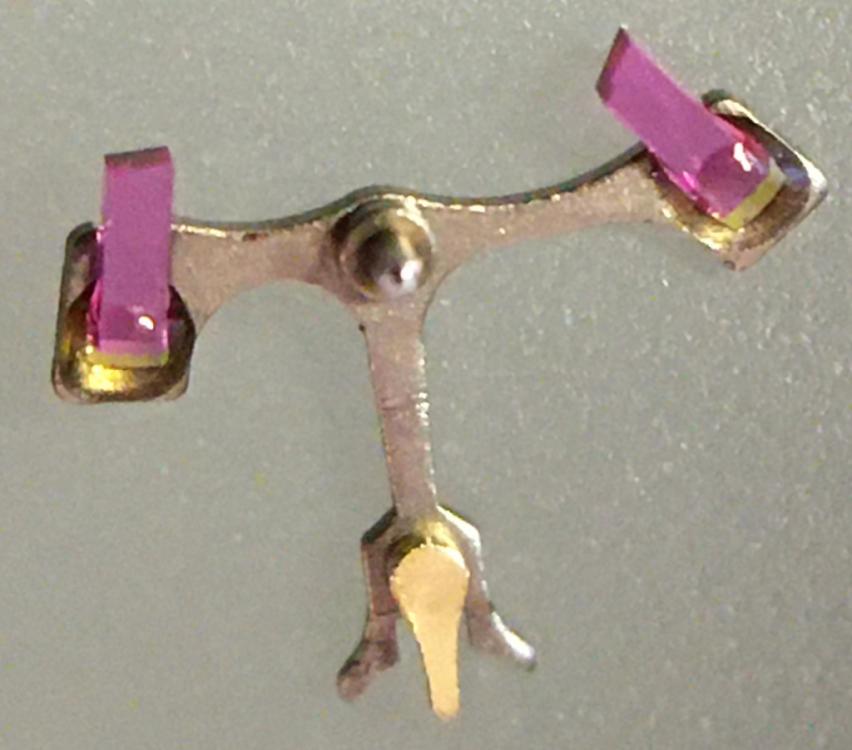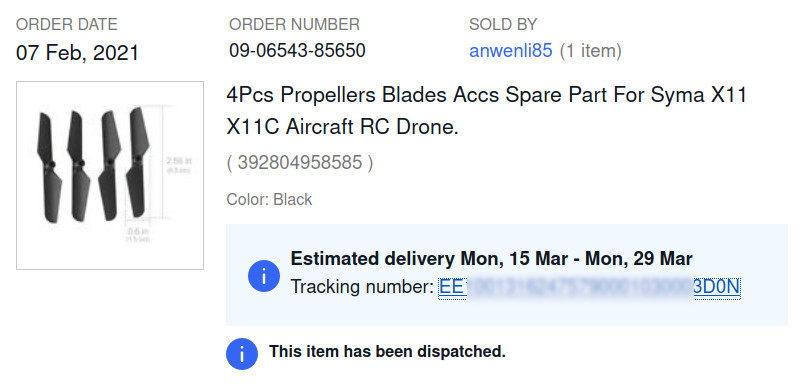Leaderboard
Popular Content
Showing content with the highest reputation on 02/27/21 in all areas
-
It has been a bit of saga but worth it. Finally cut a screw for the 8 days French alarm clock. One of the four to fasten the pillars to the base, three were missing. I am almost sure that all its sizes are in French lignes (symbol: ‴), to begin with the pitch of 4 threads per ligne (0.564mm). The head is 2‴ x 1 exactly. The pitch is easy to get if your lathe has a bunch of gears. But the profile is another story, antique threads have rounded crests and valleys. I can only hypotize on how that could be reproduced in an home shop - not easily. Anyway, just like my Swiss-exiled counselor has confirmed, with a bit of care in tool grinding and cutting the result is working and acceptable. Original on the right.4 points
-
I figured I'd post the watch that started me on this journey. It really is quite gorgeous. I saved the photos from the original ebay listing. The listing said, "ART DECO 1930s BULOVA ENGRAVED CASE WATCH NEAR MINT" I've since learned that the watch is not from the 1930's but is a 1928 Surrey. Also, not mentioned in the listing is that it was recased in an Illinois Watch Co. case. I actually like this case much more than the original Surrey case so I can't really complain about that. The only real issue is that the movement just kind floats in the case since the movement isn't actually attached to the case in any way.4 points
-
Hello I am in the Baltimore Maryland area and somehow I accidentally ordered some duplicate oils and greases... well not somehow I forgot I ordered them and order them again. Unfortunately I can’t return these because that’s the policy and i’d rather give them to someone who can use them anyway. I have 9501, 9415, and KT 22 spares. If someone’s in the area we could meet and you can have them, I would prefer to not have to mess around with shipping them. I’m hoping to give them to someone who starting up and can’t afford them but if you’re in the area and you can use them let me know. James2 points
-
Intro A while back I successfully made my first attempt refitting and adjusting pallet stones using shellac. It was something I had dreaded doing (it seemed difficult) but in the end it wasn’t that difficult at all. Having gathered experience from a few years of handling tiny watch parts using tweezers and having developed some left-hand dexterity as well (I’m right handed) probably helped. Anyway, I thought I’d share the experience with anyone who would be interested and hopefully there’ll be some other WR-talker, now or in the future, who’ll find it useful. If you’re new to this topic you might find this page and this video on the watch repair channel a good start. As I didn't want to risk ruining my Gaston tool I melted and prepared the small pieces of shellac on a chisel tool (my improvisation) that I happened to have in my tool box. However, the chisel tool had a very tough plastic y surface but I was able to burn it away to expose the bare metal with my alcohol lamp before melting and forming small pieces of shellac on it. However, the pieces of shellac needed were much smaller than what they looked like to me in the video. My way of making even smaller pieces was simply to poke the small pieces that I had made with tweezers once they had cooled and were hard. Setting and adjusting the pallet stones was easier than I thought it would be. I didn't realize the fork slots for the stones pinch the pallet stones (Vostok calibre 2414) and actually keep them in place before the shellac is applied. So, I could replace the pallet stones and then check and adjust the locking depth to the escape wheel teeth before applying the shellac. A bit fiddly yes, and you do need to develop some dexterity with tweezers before you try this but not to the point that you break a sweat. Anyway, thank god for my stereo microscope! Anyway, it was my first attempt, and as is common when you try something for the first time, I made a mistake. Despite very consciously applying what I felt was a little too little shellac it still flooded the stones and a large portion of the fork when it melted. Also, I applied too much heat so that the shellac started boiling creating bubbles. So, I decided to start all over. Fortunately, the “industrial isopropanol” (so called on eBay) that I have is very efficient so no problem removing the shellac from the stones and the fork. The second time around I only used a minuscule amount of shellac. Also, I heated the Gaston tool holding the fork in short turns, just so that the shellac would fully melt without staring to boil. Much better! The following is what I would suggest based on my first experience: Basically, follow the video I linked to above. In the video, Mark pokes and scrapes the fork and the stones with tweezers to get rid of old shellac. I tried that, but it wasn’t very efficient. Instead I would let the pallets soak in industrial isopropanol for about 10 minutes and then use a paintbrush to brush them clean. The shellac dissolves completely in the isopropanol and the stones can then be easily removed and further brushed if required. To insert or slide a stone back into the fork slot I found holding the fork by the end of the slot (opposite side of where the pallet stone is inserted) with tweezers (left hand) was giving me the most control. I placed the pivot of the fork (guard pin up, of course) in a small hole in my staking block while inserting/sliding the stones with another pair of tweezers (right hand) into the slots. After having applied the shellac Mark suggests re-heating the shellac to adjust the stones. I was worried that it might result in a mess if I tried it, so I decided to do the adjusting before applying the shellac as shown in this video. The slots for the stones pinch the stones pretty well so if you're careful while you're testing the lock to the escape wheel teeth this method works well and won't dislocate the stones. However, to make sure, double check the positions (depth and angle) of the stones before applying the shellac. Now, the tiny piece of shellac should be placed on the rear section were the stone meets the fork. Mark is clear about this in his video but for some reason it completely passed me by when I made my first attempt. In my second attempt I followed Mark's instruction, but the piece of shellac, being very asymmetrical in shape, was difficult to place in the right spot. However, after warming the pallets to the point that it had only softened the shellac a bit, I discovered, to my surprise, that I could manipulate the shellac into the perfect spot with the tip of my tweezers, without the shellac sticking to the tweezers. Of course, as I've come to realize, every repairer must find his or her own way, but hopefully you'll find my "discoveries" useful. Above is a picture of the result. It's not perfect but still worked very well. The amount of shellac on the entry stone is a bit too little, and there is a < 1 degree tilt on the exit stone (which, of course, can’t be seen in the picture).1 point
-
It was supposed to be a simple job. Just replace the battery... But then I noticed there was a speck of dust under the crystal... So I took out the movement to clean inside the crystal. Then I noticed the minute hand wasn't centred on the hour... So I removed the hands to realign them. Then the minute hand stops moving... I took off the dial and discovered that the cannon pinion popped off when I lifted off the hands. ? Now I will have to do a full disassembly to fix it. ? I have to stop being so OCD.1 point
-
https://www.mediafire.com/file/mz809lm3bms8zk3/bestfit_part1.pdf/file https://www.mediafire.com/file/mz809lm3bms8zk3/bestfit_part1.pdf/file If the others fail try these password is TICKANDTOCK again an old hippy post on media fire.1 point
-
https://www58.zippyshare.com/v/BGNuxKTX/file.html https://www105.zippyshare.com/v/xrUeOPSy/file.html Give these a try they were posted by Old Hippy. If they dont work search for bestfit catalogues. cheers1 point
-
There is always the tiny possibility that we can get a replacement and deny you your fun of making one. Then it's a shame it wasn't the right kind of stopwatch? Some stopwatch is have spare parts. Their hiding so I went online and snipped out some pictures for you. This particular example actually has a note that the parts are hiding under something. Other times it's not at least I remember it's not always shown that this is where the parts are hiding.1 point
-
One other point Identification can be checked via the bestfit books of which there was a download link posted by Old Hippy some months ago They are to big to send as pdf's but find able via the search option on the top right of the screen, worthwile finding them and downloading a copy. cheers1 point
-
I think Joe is right , as is just measure the spring length - thickness - height and barrel diameter and look it up on cousins site for a GR spring once assembled a picture of the keyless work may lead to identification for you thanks.1 point
-
Yes I did notice FB in your original post. At this point you might just go by measuring the spring itself.1 point
-
Perhaps an Ebosa, can even be a baumgartner or langendorf. Find us a trademark engraved on it some place, ebosa's mark is real small.1 point
-
".. If you are going to survive out there, you've have really got to know where your towel is.." In one of life's more surreal moments, I got a delivery through the post of one of those nondescript Chinese polythene packages. There is nothing particularly odd about that, given my tendency to order random things from half way round the planet. However the label on it stated "1 x Towel". "What? I didn't order any towel?" I thought, so assuming it was simply some way of ensuring that some bored customs officer didn't bother to check it, and that it probably actually contained some random piece of electronic circuitry, or perhaps some other thing I had ordered and forgotten about, I slit it open. Sure enough.. it contained a towel. Admittedly it is made of barely enough material to cover your eyes and thus defeat the ravenous Bugblatter Beast of Traal, but none the less, some random stranger had sent me a towel. I nervously checked outside to see if there were any large Vogon constructor fleet ships hovering in the sky. Nope. At least not so far. The mystery deepened when I checked the unique Chine Post parcel ID (on the sticky label underneath the additional sticky label affixed to it by the Post Office in the UK). It has exactly the same "unique" delivery ID as an entirely unrelated item I had already received a little while back. Furthermore when I check that item on the tracking site, it claims that the item has not yet been delivered. Very odd. I wonder what else might be in the pipeline? A fish perhaps? Maybe every single undeliverable item from the whole of China is going to turn up at my door in the next few weeks. Maybe I should grab a few pints of beer and some salted peanuts and prepare for some intergalactic travel.1 point
-
Hi Would have been better posting the complete movement, members may be able to Identify it from the setting lever spring shape and the keyless works as a string of bits its hard work. Its a pin lever movement.1 point
-
The first link shows all the watches that use this mainspring and gives us another number. Then the second link shows the mainspring is available. http://cgi.julesborel.com/cgi-bin/matcgi2?ref=qWJXEn http://www.julesborel.com/s.nl/it.A/id.28660/.f1 point
-
1 point
-
Hi, welcome to WRT from an almost retired dentist. Yes, our years of working with our hands has given us a boost in the hobby. But there are things in horology that can test the best of our skills. Good luck and enjoy your new hobby.1 point
-
1 point
-
Or you could say, "Look Dear! The prices of watches have really gone up since Covid. My watches are now worth a whole lot more now. What a clever boy I am. " ?1 point
-
Tell her the real value in your will. You won't be there to hear the swearing......1 point
-
I'm watching the first part now. I have a different version of that same roll top desk. You show your laptop on one of the pullout top extensions. I TOTALLY forgot about those! I've been expanding onto the table behind me lately (it's the dining room table, and absolutely not a sustainable solution), where it would have been so much better to just pull those things out. I love those desks! Like you, I'm still moving into mine because there are so many places for things to go.1 point
-
Hi @Domovoy - presumably your watch didn't go in totally pristine and come out battered? I assume most of this is normal wear-and-tear? If not and you feel all this is really something the watch repairer did then you should make a complaint. As a professional company they have a duty of care. If for whatever reason this is not a route you want to take then you really only have two options: 1. Keep a look out on a site like ebay for a similar watch to yours to take the bezel from (or even swap your whole movement into). 2. Polish out the imperfections on yours. For 2 do you have a rotary tool (Dremel or similar)? You can get mini felt wheels which when used with a suitable polishing compound* can achieve really good results and remove imperfections. You would have to go carefully and obviously mask that bezel insert (with tape or a cardboard disc). If you take this route I would strongly recommend you practice on something first before you get going on your bezel. Remember polishing is essentially removing microscopic amounts of material so you want to be confident you know how much pressure you need to apply etc. before you get medieval on your bezel. But with care and a range of mini wheels of different shapes you have a possible DIY route through this. * There are various ones out there. I like the Dialux range and for this would opt for Dialux Green but basically you want a final polish compound suitable for use on stainless steel.1 point
-
Hi You could also try Wm S Mccaw. thewatchguy. Dr Roland Ranfft these are but a few where information can be found. As mentioned by JohnR725 cousins where there are plentiful techsheets.. If you want general service data/training heres a few attached to get you started. By the way Welcome to the forum enjoy 1831920544_ToolsfortheHobbyist.pdf TZIllustratedGlossary.pdf Witschi Training Course.pdf1 point
-
We were taught in school to do just as you've done here, with one simplifying step: when you have your shellac strand on your pegwood, break it off leaving 2-3 mm. Now you have a shellac applicator. Heat your fork, and apply the shellac directly with the shellac-tipped pegwood. You very quickly learn how thin to pull it to have a useful "tip". This is done with sharpened pegwood.1 point
-
Servicing my 2nd Omega cal. 268 (service walk-through for my 1st here) I wasn't too happy with the state of the shellac holding the pallet stones in place. The shellac had crackled quite badly and some pieces had fallen off. So, I decided to remove and refit the pallet stones, and in the process I made a few more observations and experiences I'd like to share. 1. Removing the old shellac was not as easy as just soaking the pallets in isopropanol and brush it off. The shellac just wouldn't dissolve. The shellac only softened somewhat in the isopropanol despite leaving it in for over 30 minutes. So, I had to scrape the shellac out using pegwood dipped in isopropanol, and I even had to poke some sections of the fork slot with my most pointed tweezers (being very careful not to scratch the fork). My newly bought fresh shellac dissolves completely in isopropanol in about 10 minutes. I estimate that the old shellac was almost 60 years old and perhaps it is the case that the chemical composition of old shellac changes over time so that it becomes harder and less susceptible to isopropanol!? In that case, it explains why it is sometimes possible to rinse the pallets in isopropanol without the shellac softening, while at other times it leads to the shellac becoming very soft and soggy dislocating the pallet stones. 2. I wasn't sure it was the case that the fork slots always, or most of the time, pinch the pallet stones, but I have since then learned that the stones should always fit snugly in the slots. The exception I believe might be some very old pocket watches. Well, the point being that we can adjust the locking depth of the stones to the escape wheel teeth (as shown in the video I linked to in my previous post) before fixing the stones with shellac as long as we're being gentle. 3. I found a more efficient way to create small pieces of shellac of a more convenient size by heating the end of my shellac stick until it starts to glisten and then stick the end of a small piece of pegwood (2 mm in diameter) into it and pull out a tapered string of shellac. As long as the shellac is warm you can basically pull out a string as thin as air. Anyway, when the string is tapering from about 0.5 to 0.1 mm I stop pulling, let the shellac cool and break off the string. After this I use the tip of a sharp scalpel to cut the string into small conveniently sized pieces. 4. The Gaston tool mentioned in my previous post proved to be more useful than I first thought. As it firmly holds the fork in place it makes it easy to refit the stones by sliding them into the slots. So, no need to hold the fork steady in a staking block using tweezers held by the left hand (which feels a bit scary really). Also, the arms of the Gaston tool really makes it easy to push the stones into the slots in a very exact manner. I think that sums up most of what I learned doing this operation the second time around. So, hopefully it will be useful to present and future WR-talkers who are in the process of learning this technique.1 point
-
Just a minor clarification? So the little gold spring is no longer attached at all correct? I don't know of any videos that cover this I do have some photos though if the spring really has come out. Problem is the Chinese did not exactly clone the setting correctly and as a consequence the spring will fall out. So if that's the problem and I can find my pictures with a steady hand it's easy to fix.1 point
-
Shellac has many advantages over other types of fastening products. One big advantage is it can be drawn into thin hair size strands that are stiff enough to control. Watch parts are very small and a thin strand of shellac can be precisely deposited on the desired spot. A drop of glue on a watch part could cover the part in areas where the glue was not needed or wanted. Another advantage is, once the shellac cools an extremely small amount of it will permanently hold the stone in place. When you wish to remove the stone you only have to reheat it. Since alcohol dissolves shellac old shellac can be easily cleaned off before replacing another stone. david1 point
-
I have a flash shortcut to ETA labs 7750 calibre that showed assembly dis-assembly. It no longer works due to Adobe flash reaching EOL status. I visited ETA labs web site to see if there was an alternative and lo and behold no access to anything technical at all. Does anyone know how to get access to what we use to have access to? Looks like protectionism has escalated.0 points











